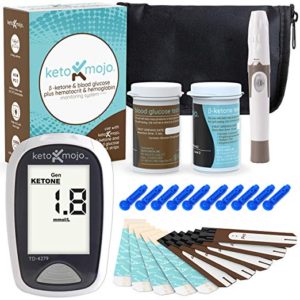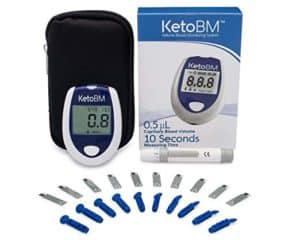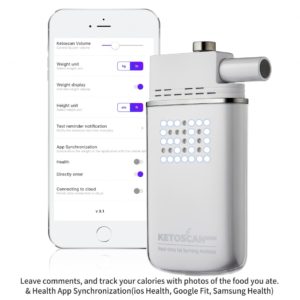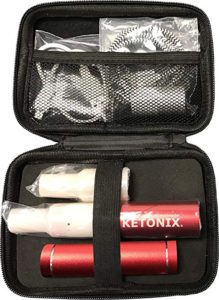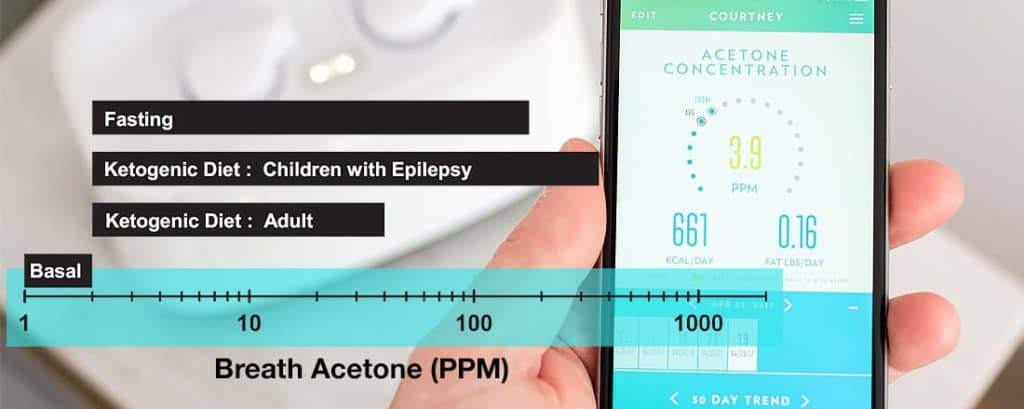One of the most important aspects of the keto diet is knowing exactly whether or not your body is actually in ketosis.
If you’re trying to get into ketosis, it can be difficult to know at first, especially if early warning signs like the keto flu simply aren’t present.
Using ketone blood and breath meters are the best ways to effectively determine whether your body is in ketosis or not. This can help when trying to isolate certain symptoms to a specific cause, track the progress of your ketosis, and check to see if certain types of foods may have actually taken you out of ketosis.
In this article, I’ll be examining both blood and breath ketone analyzers, will compare how they work, and will list some of my personal favorite kinds that I’ve used over the last couple of years while on keto.
What do Ketone Meters Do?
Ketone meters and analyzers are great ways to help you figure out if your body is in ketosis from the comfort of your own home.
Generally the most accurate ways to know if your body is in ketosis is by measuring the ketones in your breath and blood stream, but urine strips can also be telling, but are generally not as accurate as measuring breath and blood.
Ketone testing was first introduced for diabetic use to keep track of blood sugar and insulin levels, but as keto has grown more popular in recent years, they’ve started to get a lot more use as a way to validate our efforts of following a ketogenic diet.
-
Breath Ketone Analyzing
Breath ketone meters are a little new to the general market of testing ketone levels, but they’re cheaper than a doctor’s visit, and are pretty accurate and affordable too.
These breath analyzers are designed to specifically measure the exact amount of acetone that is being excreted in the breath. Acetone is a type of ketone that is largely responsible for a lot of the benefits most people get out of entering a state of ketosis.
This read on acetone is able to help provide readings that relate well to blood ketone levels at low concentrations, and can help indicate simply whether you are in ketosis or not.
The research on this method is fairly limited and it does come with some caveats. The biggest is that acetone is generally the least present of the three types of ketone bodies that are produced during ketosis, so there are still more accurate methods out there.
But for people on the go, breath analyzers make for a great way to check if something you’ve eaten has taken you out of ketosis, and can help you understand how your individual body reacts to certain high glycemic foods and carbohydrates, because everyone reacts to keto a little bit differently.
-
Blood Ketone Measurement
Now measuring via blood meters on the other hand is a lot more effective, but a little more cumbersome.
When you test your blood for ketone bodies, you’re most likely to use what is known as a BHB or glucose meter. This form of measurement is the most accurate way available aside from having your blood tested by a lab, which is obviously time consuming and much more expensive.
BHB/glucose meters are fairly portable, affordable, and are much more widely available since they were originally introduced into the market for those struggling with diabetes.
These meters work by measuring the glucose or ketone levels in your blood, depending on which test strips you insert into them.
Each type of measurement system might be a little different, so you should consult with the individual product guide when seeing if your results are confirming ketosis or not.
Some people tend to get a little squeamish when it comes to measurement via blood, but the whole process is entirely safe and not really painful at all. You just have to prick your finger, and apply a small dab of blood to the test strip to get your full results.
Which Is Better – Blood or Breath Ketone Meters?
The debate between blood or breath ketone meters really boils down to personal preference, but both have some pros and cons that you should be aware of when making your decision.
-
Blood Ketone Meters
One of the biggest pros of blood ketone meters is obviously accuracy.
Depending on the type you get, you can check for all three types of ketone bodies, and will be able to determine a specific range of ketosis that you are in, and how close you might be to pulling yourself out of ketosis if your blood sugar levels are spiking or if you’ve eaten too many carbs.
Another benefit is the ease of finding them. Because diabetes is a fairly prevalent disease, especially in America. They’re easy to find at most pharmacies, and are so widely sold online that Amazon.com has become a pretty simple and convenient way to find and compare prices and features for most blood meters.
The last big differentiating factor for blood ketone meters is the ability to measure blood glucose levels.
Many people view this feature as just a use for those with diabetes, but knowing where your blood glucose level is can also be a great way to get an idea of how your diet is affecting your body, and provide a little more insight beyond just what ketone bodies are in your blood.
A drawback of blood ketone meters however is cost. These can be pretty costly, ranging from $50 to $350 depending on the attachments, quality, ease of use, and portability that you want with your ketone blood meter.
- Breath Ketone Analyzers
Conversely to blood ketone meters, breath ketone analyzers obviously are much more affordable, with the average price coming in at around $50. While this isn’t a cheap addition to a standard diet by any means, for the value you get out of it, it’s definitely worth the price.
Breath ketone analyzers are also a little more convenient than blood meters. For starters, you don’t have to prick your finger and draw blood every time you want to see if you’re in ketosis, which most people agree is a pretty big added benefit.
They’re also convenient because you only have to purchase every component of the tool once. With blood meters and urine test strips, you’ll eventually run out of strips and will need to continue to buy more. They’re also very efficient with energy, so you won’t go through a ton of batteries trying to frequently use your breath analyzer.
The biggest drawback, as mentioned above, is that they simply aren’t as accurate as blood ketone meters. Since they’ll only ever be able to check for acetone, you won’t fully be able to get a comprehensive read on other ketone bodies in your bloodstream, and you won’t get that added benefit of knowing just where your blood glucose levels are at.
Lastly, with breath, your body can undergo a lot of changes while being in ketosis for long periods of time. Those with long term ketosis may find that there are simply less ketone bodies in their breath and urine, despite still fully being in ketosis, because the body has gotten more efficient in using them and doesn’t have to expel as many.
This is obviously a good benefit of long term ketosis, but nevertheless it does make accurately testing for ketosis a little more challenging.
All in all, both have great benefits and minimal drawbacks, which is why I recommend both types of tools for both new and seasoned keto dieters.
I’ll get into some of my personal favorites that I’ve tested for both blood and breath next.
Best Ketone Meters for 2019
The Keto Mojo blood ketone test tool is definitely one of the most popular ketone testing kits available in 2019.
One of the biggest perks of this tool kit is that it’s easy to use, and also one of the least expensive blood ketone testing strips available and with reliably high reviews.
Another reason I’m a big fan of the Keto Mojo is it’s large and easy to read display.
The screen is super easy to navigate and understand, and doesn’t make things too complicated like other blood ketone meters do.
Furthermore, because it was originally designed for diabetic use, Keto Mojo is FDA approved, and the latest models are more accurate than most competitor products.
Along with being one of the cheapest options available, reuse isn’t a big hassle either. Keto Mojo test strips come in at just under one dollar per strip, so if you eventually use all of yours, you won’t have to break the bank getting more to use.
This meter in particular also is great for measuring not only all three types of ketone bodies, but glucose levels, as well as hematocrit and hemoglobin.
Keto Mojo takes blood ketone measurement to the next level by also having bluetooth capabilities and an accompanying iOS and Android app so that you can track and log your recordings over time!
Their website has a ton of free resources as well which I encourage you to check out.
>> Click Here to Check the Price of the Keto Mojo Test Kit<<
The KetoBM Ketone Blood Meter kit is a great choice on Amazon as a recommended selection. It boasts itself as the cheapest possible option out of all Ketone testing kits, and is one of the highest rated kits available in 2019.
One of the best aspects of this is for the low price, you still the complete kit with your purchase.
The kit includes everything that you would need for testing your blood ketone levels at home, including the meter itself, 10 ketone strips, the lancing device, and 10 lacnet.
It’s also one of the easiest test kits to use, made for individual control use from the very start. You won’t have to calibrate anything or program anything, and the results will be readily available on it’s large and easily readable display screen.
KetoBM prides itself on putting accuracy at the forefront of the product’s design, with a state of the art monitoring system that time and time again has provided the most accurate and reliable results, tested against actual lab-certified blood tests for precision.
Some drawbacks are of course the diversity of the kit. Other blood ketone test kits will come with a lot more strips and lacnet, which definitely is more convenient especially if you plan on testing your blood ketone levels multiple times per week.
Fortunately ketone lancet and strips from KetoBM are very cheap and affordable, and contribute to it being one of the cheapest on the market today.
If you’re not happy with your product, or if there are any issues, they offer both a 30 day money back guarantee and a 2 year repair or replacement warrantee, making it one of the most consumer-friendly options in my opinion.
>> Click Here to Check the Price of the KetoBM Test Kit<<
Switching gears into breath analyzers, I want to give a huge shoutout to KetoScan. While the price might seem pretty steep at first, the benefits you get out of this thing are phenomenally worth it.
The Ketonix Reusable Breath Analyzer is one of the first breath analyzer’s made for keto ever made. Hailing from a Swedish health care parent company, the device is small, simple, and easy to use.
It’s roughly the size of a whiteboard marker, so it’s extremely easy to carry around for ketone testing while on the go.
Additionally, it can be used either wirelessly by using the battery that it comes packaged with, or by connecting the device through a provided USB cable, so you can charge it with your laptop or other devices if you’re traveling and still want to get those acetone readings.
Like other blood meters, it’s state of the art in terms of tracking and user interface. Ketonix comes with a software that you can use on your desktop or mobile phone, and let’s you keep track of your past and present states of ketosis.
The one I’m reviewing is the latest model, but they have models that date back years that are still solid products if you’re looking for a lower price.
Some bigger drawbacks about it is availability. It’s not as easily available in stores and online retailers because it comes from Europe. Fortuantely if you’re in the US, Canada, or UK, Amazon.com has a pretty solid workaround with decent shipping options. (You can check it out on Amazon right here).
Another drawback is battery life, which isn’t as great as other wireless brands. That’s why I’m glad they include a free USB cable, which makes charging options at least a little more versatile since the battery can often go out.
>> Click Here to Check the Price of the Ketonix Breath Analyzer<<
The Bruno MD6 is easily one of the best blood monitoring systems for ketones out there. It’s a little pricier than something like the Keto Mojo, but it is very sophisticated.
The whole kit comes with a state of the art ketone and glucose reading device, a lancing device for accurate blood testing, two AAA batteries, two manuals, a daily log journal, a travel carrying case, 10 glucose test strips, a box of ten separate keto test strips, a full five year warranty, and a whopping 50 lancets!
While the price does seem like a bit of a drawback, other kits simply don’t come with as many add ons and features, so you don’t have to pay out of pocket for extra lancets, batteries, a travel case, and a journal to log all of your keto progress.
How to Use Ketone Meters
When using either blood or breath ketone meters and analyzers, you’re going to want to know exactly what to look out for in terms of achieving optimal levels of ketosis.
Most readouts will be around a scale of 1 to 3. The sweet spot for optimal levels of ketosis is between 1.5 and 3. Once you get above a seven, that’s when your body is in ketoacidosis.
Anything below a 1.5 means that you haven’t quite entered ketosis yet.
One of the important things to consider when evaluating your blood ketone levels is that ketone levels in your blood do not stay consistent throughout the day
Factors like alcohol consumption, exercise, and spikes in blood sugar from certain types of foods can all contribute to changes in your ketone blood levels.
Because of this, if you plan on checking every day or every week, you should check your ketone blood levels at the same exact time of the day as the last reading, for optimal results.
This also assumes that you’re eating a pretty consistent diet day to day, and aren’t wildly experimenting with certain types of intermittent fasting.
For example, going from a set amount of multiple meals per day, and then switching to something like the OMAD Diet (One Meal A Day) can obviously cause some changes in your readings.
The process of actually taking a blood measurement is fairly quick and simple as well:
- Insert a needle into the lancet pen of your product according to the specific package instructions.
- Wash your hands thoroughly with soap and dry well before beginning.
- Select a test strip from the packaging and insert it into your blood ketone meter.
- Put the lancet pen on the side of your fingertip and gently press the button to prick your finger.
- Continue to gently squeeze your finger in order to get a droplet of blood out. You will need a fairly large drop to properly be tested.
- Slowly touch the end of the test strip to the droplet of blood on your finger until it completely fills the little opening and the meter is able to register it.
- Wait for a few seconds for the meter to provide a reading
- Mark down your results and compare them against the optimal ketone levels
Evaluating ketones in your breath is a little bit different.
For starters, there’s a different types of measurement in place for measuring ketones in the breath. For breath analysis, you’ll just be looking for acetone levels in PPM (parts per million).
Each breath analyzer is going to give off different reads for ketosis, so you’ll want to check with your manual for the specific product that you use.
Some general tips for using breath analyzers are a little similar to that of blood ketone meters.
As you might have guessed, you’ll also want to try and limit your monitoring time to be around the same time of day every day, if you have a consistent diet. Like blood ketones, a lot of different factors can affect the acetone levels in your breath. In order to get a scientific and accurate reading, you’ll want to control the measurement environment as much as possible.
Additionally, you may want to shy away from measuring your breath in the morning because of something known as the “dawn effect”. Typically after waking, research has found that ketone levels tend to be much lower and glucose levels tend to be much higher as a natural result of sleep.
Measuring is a lot easier than taking a prick of blood from your finger. For the given breath analyzer you’re using, you’ll want to follow the short, but easy instructions.


